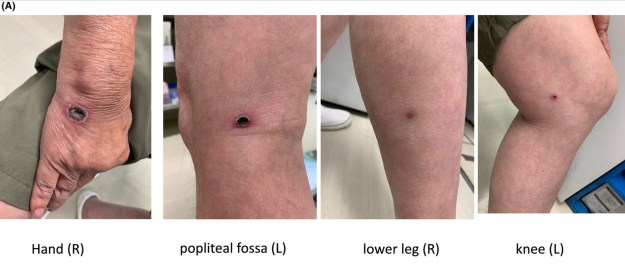Background:
mRNA is short for messenger RiboNucleic Acid. It is a single-stranded molecule of RNA. It is transcribed from a DNA template. The role of mRNA is to make proteins:
The role of mRNA is to carry protein information from the DNA in a cell’s nucleus to the cell’s cytoplasm (watery interior), where the protein-making machinery reads the mRNA sequence and translates each three-base codon into its corresponding amino acid in a growing protein chain.
Pfizer’s and Moderna’s mRNA vaccines make spike proteins. The body will see those spike proteins as foreign and mount an immune response. That immune response is subsequently enlisted if the body ever meets the spike protein on the actual Sars-CoV-2 virus.
For some reason (see below*) the vaccinated person’s body keeps producing spike protein long after it’s necessary. That may be a problem because scientists are finding the spike protein itself can be toxic. Here’s a case where the spike protein was found in shingles lesions months after vaccination:
Persistent Varicella Zoster Virus Infection Following mRNA Covid-19 Vaccination Was Associated With The Presence Of Encoded Spike Protein In The Lesion, Cutaneous Immunology and Allergy, 25 August 2022
Since the campaign of vaccination against COVID-19 was started, a wide variety of cutaneous adverse effects after vaccination has been documented worldwide. Varicella zoster virus (VZV) reactivation was reportedly the most frequent cutaneous reaction in men after administration of mRNA COVID-19 vaccines, especially BNT162b2.
…
A patient, who had persistent skin lesions after BNT162b2 vaccination for such a long duration over 3 months, was investigated for VZV virus and any involvement of vaccine-derived spike protein.
…
The diagnosis of VZV infection was made for these lesions using PCR analyses and immunohistochemistry. Strikingly, the vaccine-encoded spike protein of the COVID-19 virus was expressed in the vesicular keratinocytes and endothelial cells in the dermis.
Endothelial cells are blood-vessel-lining cells. What is the spike protein doing in blood vessels and skin, far from the injection site, 3 months later? (Indeed, this man suffered from vasculitis or inflamed blood vessels also.) The CDC assured us that the body gets rid of the mRNA in a few days and the spike in a few weeks.
Also curious is why anyone would experience a reactivation of herpes zoster or shingles after a vaccine:
VZV reactivation frequently arises under immune-exhaustion, such as aging, or immunocompromised conditions caused by immunosuppressive drugs, HIV infection, or malignancies.
Does the vaccine suppress the immune response? Yes, if this paper is anything to go by:
Innate immune suppression by SARS-CoV-2 mRNA vaccinations: The role of G-quadruplexes, exosomes, and MicroRNAs, Food and Chemical Toxicology, June 2022
The authors of this shingles study suggest that the spike protein itself may be responsible for immunosuppression:
The SP [spike protein] could be the culprit for immunosuppression that allowed VZV reactivation and its persistence, as well as skin vasculopathy and thrombosis.
* Finally, why does the body continue making spike? Three months is a long time, especially given the CDC’s claim that all spike is cleared after a week or two. Here’s one hypothesis:
A plausible hypothesis was that the stabilization of RNA by substituting methyl-pseudouridine for all the uridine nucleotides for BNT162b2 [Pfizer/BioNTech’s vaccine] might result in long-time production of the encoded SP from any cells.
By the way, this was a Japanese study. Physicians in this country don’t as a rule study or discuss the effects of the covid vaccine (or at least don’t let on). They risk losing their medical licenses if they do.
No one knows how long the body will continue manufacturing spike protein from the injected mRNA. This man may be dealing with these painful lesions for an indefinite amount of time.

“Clinical manifestations and histopathology. (A) Clinical features at the first visit (the day 10 of disease onset, 2 days after the second dose of BNT162b2). Painful necrotic nodules and vesicopapules in the extremities.”
Shingles is just one side effect of the mRNA vaccines. Effects differ depending upon where the mRNA travels, where the spike protein travels. (We were told it didn’t travel.) Skin cells regenerate, fortunately. Cardiac cells not so much. I feel for the young people who are experiencing heart inflammation (myocarditis) from the vaccine. That will be an injury that will follow them into adulthood.
Thanks to Alex Berenson for reporting on this: mRNA Shots Are The Gift That Keeps On Giving.

